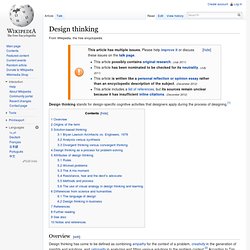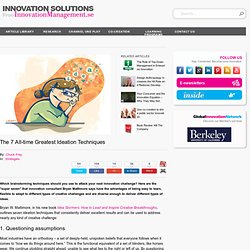

Graphic Design Inspiration, Blogs, Business & Career Advice. Jump Start. Jump Start continued...

Did you enjoy this game? Then try Free the Genie Top News & Offerings. Jon Kolko » Abductive Thinking and Sensemaking: The Drivers of Design Synthesis. Overview: Making Sense of Chaos Designers, as well as those who research and describe the process of design, continually describe design as a way of organizing complexity or finding clarity in chaos.

Jeff Veen, founder of Adaptive Path, has noted that "Good designers can create normalcy out of chaos. "[1] 1 Jeff Veen, The Art and Science of Web Design (Indianapolis: New Riders Press, 2000). Jon Kolko » Information Architecture and Design Strategy: The Importance of Synthesis during the Process of Design. Abstract During the process of design, Designers attempt to draw connections between seemingly disparate ideas; they examine quantitative data provided from marketing and qualitative data gathered from end users, and before they can begin designing, they must make order out of the chaotic mess of research.

The connections that can be formed during this synthesis phase frequently hold the keys to "innovation". Designers visually explore large quantities of data in an effort to find and understand hidden relationships. These visualizations can then be used to communicate to other members of a design team, or can be used as platforms for the creation of generative sketching or model making.
Frequently, the action of diagramming is a form of synthesis, and is a way to actively produce knowledge and meaning. The Character of Design, by Steve Baty. Posted by core jr | 14 Mar 2012 | Comments (2) By txd, via Wikimedia Commons Without an understanding of the underlying characteristics of Design, we restrict our ability to improvise and innovate the processes and methods we use to undertake our work as designers.

A lack of discourse about Design quickly leads to stagnation, unless external sources provide a transformative—evolutionary or revolutionary—influence. It is a sign of a lack of reflection, self-awareness and critical analysis. As designers looking to improve our Design work, such reflection plays an important role, for it allows us to look at several facets of Design at once: » Quality of execution of our process and methods » Appropriateness of the process and methods to the challenge at hand » Success of our designs Project post-mortems tend to look at the first of these two; our customers (or lack) tell us the third. Intent There are, then, several different considerations in operation during the design activity. Design Thinking. WHAT IS DESIGN THINKING?

Design Thinking is a practical tool for integrating 21st century skills and an innovator’s mindset into the classroom, school and workplace. It demonstrates the direct connection between content students learn in class and what the world beyond their school will ask of them. Students are inspired. They take an active role in their own learning. Developed at the Stanford d.school, Design Thinking is a methodology that teaches individuals new strategies to solve problems. The design process is taught through problem scenarios called “design challenges,” which can range from redesigning a school backpack so that it better meets the need of an individual student, to answering the question, “How might we improve the physical and emotional safety of youth at our school?”
The process has five stages, which can occur simultaneously and can be repeated. HOW IS IT DIFFERENT FROM TRADITIONAL EDUCATION? Design thinking. Design thinking stands for design-specific cognitive activities that designers apply during the process of designing.[1] Overview[edit] Design thinking has come to be defined as combining empathy for the context of a problem, creativity in the generation of insights and solutions, and rationality in analyzing and fitting various solutions to the problem context.[2] According to Tim Brown, CEO and president of IDEO, the goal of Design Thinking is "matching people’s needs with what is technologically feasible and viable as a business strategy" [3] The premise of teaching Design Thinking is that by knowing about how designers approach problems and the methods which they use to ideate, select and execute solutions, individuals and businesses will be better able to improve their own problem solving processes and take innovation to a higher level.

Origins of the term[edit] (For a detailed evolution, see History, below.) Solution-based thinking[edit] Bryan Lawson Architects vs. Lawson found that: The 7 All-time Greatest Ideation Techniques. Which brainstorming techniques should you use to attack your next innovation challenge?

Here are the "super seven" that innovation consultant Bryan Mattimore says have the advantages of being easy to learn, flexible to adapt to different types of creative challenges and are diverse enough to deliver different types of ideas. Bryan W. Mattimore, in his new book Idea Stormers: How to Lead and Inspire Creative Breakthroughs, outlines seven ideation techniques that consistently deliver excellent results and can be used to address nearly any kind of creative challenge: 1. Questioning assumptions.